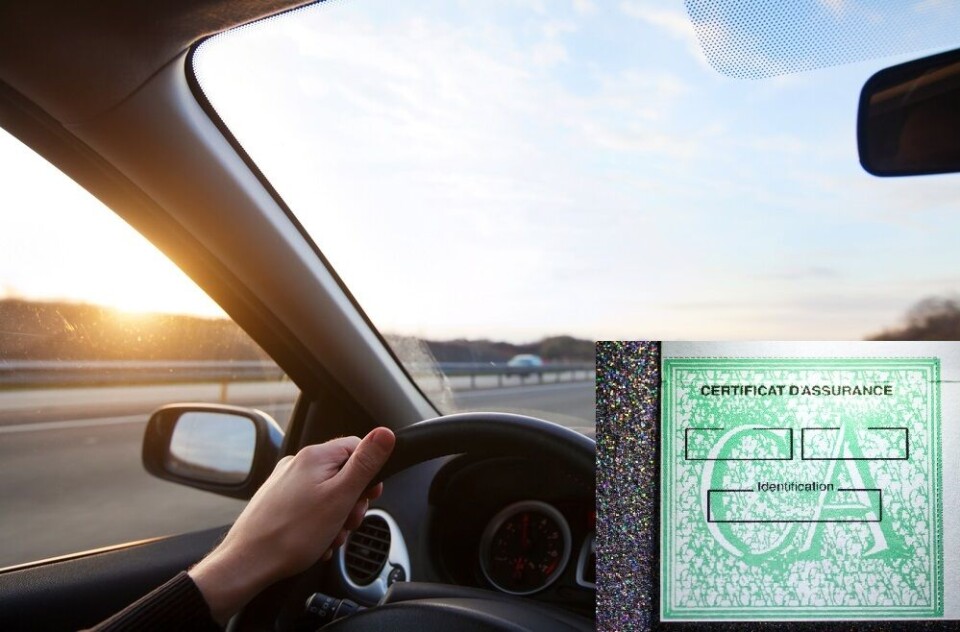-
French court hands out prison sentences and damages in Brigitte Macron cyberbullying cases
Ten people were found guilty over online comments claiming the president wife is a transexual woman and paedophile
-
France targets imports from South America over banned chemical concerns
Avocados, mangoes, and cherries among food items set to be tested before entry
-
Hazelnut, chocolate… pork? France’s traditional galette des rois gets a modern makeover
January 6 marks Epiphany and the famous galette, eaten across France
End of green car insurance sticker in France: Eight questions answered
From April 1, drivers will no longer have to display vignette on their windscreens

Drivers in France will not have to show physical proof that they have car insurance from April 1, under government plans to digitise the system.
The plan was announced by Economy Minister Bruno Le Maire in 2022.
What is the green insurance sticker (carte verte)?
The green sticker, or carte verte, also known as the papillon vert has been mandatory since 1986. Drivers would receive a paper document, renewed and sent every year from insurers, as well as a green sticker they had to their windscreens as proof that they had car insurance.
They faced a €35 fine if they were not able to present valid proof of insurance, even if they were covered.
What is changing?
From April 1, drivers will no longer have to fix a green sticker to their vehicle windscreens. The paper certificate is being retired in favour of a digital system.
If a driver is stopped, he or she will now no longer have to show any proof of insurance to police.
Instead, authorities will check the number plate against the Fichier des Véhicules Assurés (FVA), or Insured Vehicles File. This database has included all the insurance information of French vehicles since 2019.
Read more: A guide to French car insurance
What is aMémo Véhicule Assuré?
Insurance companies will issue drivers with a Mémo Véhicule Assuré to use in the first few days after applying for insurance, as it can take around 72 hours for the insurance details to be updated on the FVA.
This will usually be a credit card-sized bit of paper that drivers must place in the vehicle as proof of insurance. It can also be issued digitally, depending on the insurer.
It includes important information about your insurance plan, such as your policy number, so insurers recommend you keep it in your vehicle.
What information do I need in case of an accident?
Another reason why it is worth keeping your Mémo Véhicule Assuré handy is that it includes all the necessary information you might need in the case of an accident or breakdown, according to insurer MAAF.
What about foreign vehicles or driving abroad?
The new system is built on the Green Card Free Circulation Area (GCFCA) agreement that covers 35 countries - including the UK and all of the EU.
This means that when the insurance sticker is phased out April 1, the French authorities will allow police from other countries in the GCFCA to consult drivers’ insurance status by scanning their number plates.
Likewise, drivers visiting France from these 35 countries should find that their insurance details are already accessible to police.
Read more: End of car insurance stickers in France: what about driving abroad?
What happens if I am not insured?
The new system does not change the fact you will need to be insured to drive on French roads.
Economy Minister Bruno Le Maire was clear that all motorised vehicles would still need insurance when he announced the scrapping of the carte verte.
Drivers who do not have insurance face a fine of €3,750. Drivers could also face penalties including having their licence suspended or cancelled, or their vehicle confiscated.
The insurance details of every vehicle in France should be included in the FVA database, but if, for some reason, your insurance details are not included and you are fined for a lack of insurance, you can contest the fine within 45 days, with the Agence nationale de traitement automatisé des infractions (ANTAI).
Will premiums come down in price as a result?
While the changes will save insurance companies money – they will no longer need to print, package and send out the certificates and stickers – whether those savings will translate to savings for insurance customers is less clear.
No announcements to this effect have been made and premiums were generally still expected to rise this year. See here for more.
Why the change?
The Economy Ministry said the move to a digital system will be more environmentally friendly, as well as help to fight against fraud.
The green stickers could be easily faked, and drivers could technically cancel their insurance at any point in the year but continue to display the sticker.
Economy Minister Bruno Le Maire said going digital will save on the “significant ecological cost” of printing the stickers, which creates almost 1,200 tonnes of CO2 every year.
Bonne nouvelle pour les automobilistes ! Nous supprimons la vignette verte à placer sur le pare-brise.
— Bruno Le Maire (@BrunoLeMaire) December 7, 2023
Fini les amendes parce que ce n’est pas affiché sur le pare-brise.
Fini la paperasserie trop longue.
Fini l’impression de cette vignette qui a un coût écologique important de… pic.twitter.com/mEVQzwFBA8
Read more
Where in France is it cheapest to repair a car?
Dashcams: do French courts and insurance firms accept the images?
























